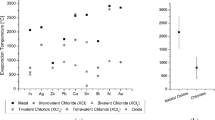Abstract
Titanium and iron are closely related in nature. Therefore, for both environmental and economic reasons, the fate of iron may be very crucial for the titanium extraction industry. Smelting of ilmenite to produce titania slag allows for the recovery of iron as high purity pig iron. However, in the production of synthetic rutile from ilmenite sands, iron is returned to the mine site as a fine oxide/hydroxide residue. Some projects to recover iron from these residues never reached the industrial scale. In the titanium dioxide (TiO2) pigment industry, iron is deported as sulfate or chloride salt, which is usually neutralized and rejected at a considerable cost. In the past few years, ferrous sulfate heptahydrate (or copperas) and iron chloride have found a few applications, but still the demand for these iron salts is not enough to cover the production volumes. The review of some new processes currently under development clearly shows that iron recovery is essential for the long-term viability of any new ilmenite upgrading or TiO2 pigment production process.
Similar content being viewed by others
References
Mineral Sands Annual Review 2008 (Victoria Park, W. Australia: Minerals International Pty Ltd., 2008).
J. Kischkewitz, W.D. Griebler, and M. de Liedekerke, Industrial Inorganic Pigments, 2nd edition, ed. G. Buxbaum (Weinhelm, Germany: Wlley-VCH, 1998), pp. 43–82.
T. Ikeshima, Titanium Science and Technology, ed. G. Lutjerng, U. Zwicker, and W. Bunk (Oberursal, Germany: DGM-Deutsche Gesellschaft für Materialkunde, 1985), pp. 3–14.
J. Barksdale, Titanium, Its Occurrence, Chemistry, and Technology, 2nd edition (New York: The Roland Press Company, 1966).
Titanium Dioxide Manufacturers Association, Process Bref Titanium Dioxide, Background Document (Brussels: CEFIC European Chemical Industry Council, 2001).
E. Reck and M. Richards, Pigment & Resin Technology, 28(3) (1999), pp. 149–157.
N. Osterwalder et al., Journal of Nanoparticle Research, 8 (2006), pp. 1–9.
T.E. Norgate, S. Jahanshahi, and W.J. Rankin, Journal of Cleaner Production, 15(8–9) (2007), pp. 838–848.
M. Guéguin and F. Cardarelli, Mineral Processing & Extractive Metallurgy Review, 28 (2007), pp. 1–57.
T Chernet, Mineralogy and Petrology, 67 (1999), pp. 21–32.
L. Fromanek, H. Lomert, and A.N. Beyzavi, Heavy Minerals 1997, ed. R.E. Robinson (Johannesburg, S. Africa: The South African Institute of Mining and Metallurgy, 1997), pp. 161–168.
G.B. Sadykhov and I.A. Karyazin, Russian Metallurgy (Metally), (6) (2007), pp. 447–454.
TP. Battle, D. Nguyen, and J.W. Reeves, The Paul E. Queneau Internationa Symposium: Extractive Metallurgy of Copper, Nickel and Cobalt, vol. 1, ed. R.G. Reddy and R.N. Weizenbach (Warrendale, PA: TMS, 1993), pp. 925–943.
P.C. Pistorius, Scandinavian Journal of Metallurgy, 31 (2002), pp. 120–125.
P.C. Pistorius, Metallurgical and Materials Transactions B, 34B (2003), pp. 581–588.
P.C. Pistorius, Journal of the South African Institute of Mining and Metallurgy, 103 (2003), pp. 509–514.
P.C. Pistorius, Journal of the South African Institute of Mining and Metallurgy, 104(2004), pp. 417–422.
K. Borowlec et al., “Method to Upgrade Titania Slag and Resulting Product,” U.S. patent 5,830,420 (3 November 1998).
K. Borowiec et al., “TiO2 Containing Product Including Rutile, Pseudo-brookite and llmenite,” U.S. patent 6,531,110 (11 March 2003).
J.J. Solheim, Proceedings of the Norwegian Conference on llmenite Smelter (Norway: 1988), pp. 177–199.
Z. Yuan et al., Minerals Engineering, 19 (2006), pp. 975–978.
Bateman Engineering NV, “Construction of Titania Smelter Plant for CYMG in China,” Bateman Globe, (Aug. 2008), p. 2; www.batemanengineering.com/Globe71/Construction_of_Titania_Smelter_Plant_for_CYMG_in_China.html, (accessed on June 25, 2009.)
P.C. Pistorius, Journal of the South African Institute of Mining and Metallurgy, 108 (2008), pp. 35–43.
G.E. Williams and J.D. Steenkamp, South African Pyrometallurgy 2006, ed. R.T. Jones (Johannesburg, S. Africa: The South African Institute of Mining and Metallurgy, 2006), pp. 181–188.
M. Gous, Journal of the Southern African Institute of Mining and Metallurgy, 106 (2006), pp. 379–384.
H. Kotzé, D. Besslnger, and J. Beukes, South African Pyrometallurgy 2006, ed. R.T. Jones (Johannesburg, S. Africa: The South African Institute of Mining and Metallurgy, 2006), pp. 203–214.
R.G. Becher et al., Proceedings of the Australasian Institute of Mining and Metallurgy, (214) (1965), pp. 21–43.
B.F. Bracanin, R.J. Clements, and J.M. Davey, Proceedings of the Australasian Institute of Mining and Metallurgy (275) (1980), pp. 33–42.
C. Li and R.R. Merrltt, Australian Journal of Chemistry, 43 (1990), pp. 1–9.
H. Aral et al., “Treatment of Titaniferous Materials,” PCT World Patent WO/1994/003647 (17 February 1994).
I.W. George, The Sir Maurice Mawby Memorial Volume, 2nd edition, ed. J.T. Woodcock and J.K. Hamilton (Victoria, Australiane Australasian Institute of Mining and Metallurgy, 1993), pp. 1301–1304.
N.R. Strange, in Reference 31, pp. 1308–1311.
S.J. Mackowski and B.J. Reaveley, in Reference 31, pp. 1304–1308.
C.B. Ward, “The Production of Synthetic Rutile and By-product Iron Oxide Pigments from Ilmenite Processing” (Ph.D. Thesis, Murdoch University, Perth, W.Australia, 1990).
N.R. Iammartino, Chemical Engineering, 83(11) (1976), pp. 100–101.
T.S. Mackey, JOM, 46(4) (1994), pp. 59–64.
E.A. Walpole and J.D. Winter, Chloride 2002, vol. 2, ed. E. Peek and G. W. Van Weert (Montreal, Canada: Canadian Institute of Mining, Metallurgy and Petroleum, 2002), pp. 401–415.
D. Velhurst et al., Chloride 2002, vol. 2, ed. E. Peek and G.W. Van Weert (Montreal, Canada: Canadian Institute of Mining, Metallurgy and Petroleum, 2002), pp. 417–432.
Author information
Authors and Affiliations
Corresponding authors
Rights and permissions
About this article
Cite this article
Filippou, D., Hudon, G. Iron removal and recovery in the titanium dioxide feedstock and pigment industries. JOM 61, 36–42 (2009). https://doi.org/10.1007/s11837-009-0150-3
Published:
Issue Date:
DOI: https://doi.org/10.1007/s11837-009-0150-3




